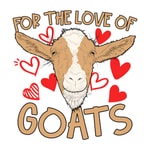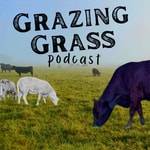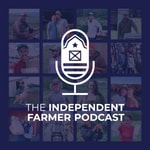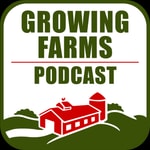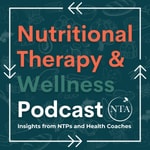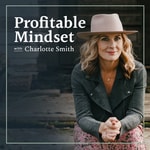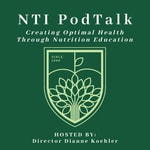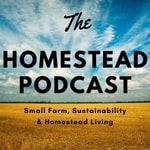The Stockman Grassfarmer Podcast – Détails, épisodes et analyse
Détails du podcast
Informations techniques et générales issues du flux RSS du podcast.
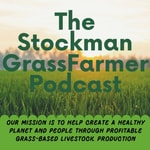
The Stockman Grassfarmer Podcast
The Stockman Grassfarmer
Fréquence : 1 épisode/20j. Total Éps: 70
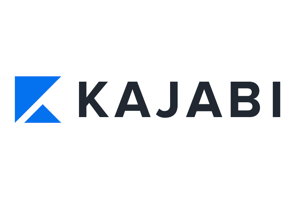
Classements récents
Dernières positions dans les classements Apple Podcasts et Spotify.
Apple Podcasts
🇨🇦 Canada - courses
01/08/2025#35🇺🇸 États-Unis - courses
01/08/2025#74🇨🇦 Canada - courses
31/07/2025#74🇺🇸 États-Unis - courses
31/07/2025#51🇨🇦 Canada - courses
30/07/2025#49🇨🇦 Canada - courses
29/07/2025#29🇺🇸 États-Unis - courses
28/07/2025#83🇺🇸 États-Unis - courses
24/07/2025#87🇺🇸 États-Unis - courses
23/07/2025#81🇺🇸 États-Unis - courses
21/07/2025#73
Spotify
Aucun classement récent disponible
Liens partagés entre épisodes et podcasts
Liens présents dans les descriptions d'épisodes et autres podcasts les utilisant également.
See allQualité et score du flux RSS
Évaluation technique de la qualité et de la structure du flux RSS.
See allScore global : 52%
Historique des publications
Répartition mensuelle des publications d'épisodes au fil des années.
Permanent Fencing Options by Brandon Mitchell
Épisode 31
mercredi 18 septembre 2024 • Durée 10:55
🎥 Unlock Exclusive Grazing Education – Anytime, Anywhere!
Get instant access to 100+ hours of expert-led grazing courses with SGF TV—all for our lowest monthly price ever! New titles added, price stays the same, cancel anytime.
📲 Tap the link to start streaming now!
www.stockmangrassfarmer.digital/sgfv-podcast
>>>
🎙️ Episode Title: Permanent Fencing Options
📝 Featured Article: Permanent Fencing Options by Brandon Mitchell
In this episode of the Stockman Grassfarmer Podcast, we explore essential choices for permanent fencing, a cornerstone of effective farm management. Whether managing cattle, goats, or hogs, selecting the appropriate fencing can significantly impact your livestock's well-being and land management. We cover the three primary types of fencing—barbed wire, high-tensile electric, and field fence—each with its unique benefits and challenges tailored to different livestock, property sizes, and terrains.
🔑 Key Points Covered:
-
Types of Fencing:
A comprehensive overview of barbed wire, high-tensile electric, and field fence. Each type is examined for its suitability depending on the specific needs of your livestock and property. -
Cost and Maintenance:
A comparison of costs and maintenance requirements for each fencing type. This includes initial investment, long-term upkeep, and durability. -
Best Fencing Options by Species:
Recommendations on the most effective fencing choices for different types of livestock, such as cattle, goats, and hogs. -
Pros and Cons:
Analyzing the advantages and disadvantages of each fence type in relation to property size, local weather conditions, and potential wildlife interactions. -
Decision-Making Tips:
Guidance on upgrading existing fencing or installing new systems, offering valuable insights for making informed decisions to enhance farm success.
🌱 Tune in now to make the best fencing choice for your livestock and land management needs! For more detailed information, check out our monthly magazine, live events, and the latest specials here.
Smart & Special: The Big Picture with Joel Salatin (Part 2)
Épisode 30
mercredi 3 avril 2024 • Durée 32:42
🎥 Unlock Exclusive Grazing Education – Anytime, Anywhere!
Get instant access to 100+ hours of expert-led grazing courses with SGF TV—all for our lowest monthly price ever! New titles added, price stays the same, cancel anytime.
📲 Tap the link to start streaming now!
www.stockmangrassfarmer.digital/sgfv-podcast
>>>
🎙️ Episode Title: Smart & Special: The Big Picture with Joel Salatin (Part 2)
📝 Featured Speaker: Joel Salatin
In Part 2 of Joel Salatin's Smart & Special series, Joel dives into advanced strategies for sustainable farming, focusing on financial management, diversifying income streams, and maximizing farm profitability. He emphasizes capital preservation, creative revenue generation through agritourism, and the benefits of stacking multiple enterprises on a single property. Joel provides actionable advice on niche markets and strategic planning to help farmers thrive in a competitive landscape.
🔑 Key Points Covered:
-
Financial Management and Capital Preservation:
Joel stresses the importance of preserving capital and managing cash flow. He advises against depleting resources and suggests renting or sharing equipment to maintain financial flexibility. He also introduces a payback period framework for investments: green light for three years, yellow light for three to seven years, and red light for over seven years. -
Diversifying Income Streams and Agritourism:
Joel highlights the potential for additional revenue through agritourism. He provides examples such as farm tours, events, classes, and workshops, including creative ideas like farm Olympics and pizza nights. He encourages farmers to leverage their unique assets to attract visitors and create differentiated experiences. -
Stacking Enterprises on a 10-Acre Farm:
Joel illustrates how to maximize profitability by stacking multiple agricultural enterprises on a 10-acre farm. He covers raising various livestock, growing crops, beekeeping, and offering value-added products. The idea is to create a complementary mix of activities that can generate substantial revenue and support multiple full-time workers. -
Niche Markets and Differentiation:
Joel advocates for exploring niche markets and differentiating farm offerings. He provides examples like customized rose cultivation and artisanal food production. He emphasizes the importance of branding, storytelling, and offering unique products to attract customers and command premium prices. -
Mission Statement and Strategic Planning:
Joel underscores the value of a clear mission statement for guiding business decisions and attracting collaborators. He also stresses the need for measurable objectives, a written roadmap, and strategic planning to effectively allocate resources and avoid costly mistakes.
🌱 Actionable Insights:
- Preserve capital and maintain financial flexibility by renting or sharing equipment instead of making outright purchases.
- Explore agritourism opportunities, such as farm tours and events, to create additional revenue streams and attract visitors.
- Consider stacking multiple complementary enterprises on your property to maximize profitability and operational efficiency.
- Differentiate your offerings by exploring niche markets, branding, and storytelling to create unique experiences and command premium prices.
- Develop a clear mission statement to guide your business decisions and attract collaborators.
- Create measurable, timed, and precise objectives, along with a written strategic plan, to effectively prioritize tasks and allocate resources.
For more insights and updates, check out our monthly magazine, live events, and the latest specials here.
rebroadcast from The Profitable Mindset podcast with Charlotte Smith...Meet Joel Salatin
Épisode 21
jeudi 23 mars 2023 • Durée 01:39:29
🎥 Unlock Exclusive Grazing Education – Anytime, Anywhere!
Get instant access to 100+ hours of expert-led grazing courses with SGF TV—all for our lowest monthly price ever! New titles added, price stays the same, cancel anytime.
📲 Tap the link to start streaming now!
www.stockmangrassfarmer.digital/sgfv-podcast
>>>
Welcome to the SGF podcast
our mission is to help create a healthy planet and people through profitable grass-based livestock production
Grassfarming is a 24-7 job and you can’t always get away. So we’ve put together this podcast, so that you can listen while you work (or whatever you’re doing) but always on your schedule. Whenever and where ever you want.
Learn more about The Graziers’ School of Marketing and Social Media https://www.stockmangrassfarmer.digital/marketing
Learn more about Charlotte Smith https://charlottemsmith.com/159-the-worlds-most-famous-farmer-is-on-the-podcast-today/
For more information, check out our monthly magazine, live events, and the latest specials here.
Joel Salatin Interviews Temple Grandin (Part 2 of 2)
Épisode 20
mercredi 24 août 2022 • Durée 45:58
🎥 Unlock Exclusive Grazing Education – Anytime, Anywhere!
Get instant access to 100+ hours of expert-led grazing courses with SGF TV—all for our lowest monthly price ever! New titles added, price stays the same, cancel anytime.
📲 Tap the link to start streaming now!
www.stockmangrassfarmer.digital/sgfv-podcast
>>>
🎙️ Episode Title: Joel Salatin Interviews Temple Grandin (Part 2 of 2)
📝 Featured Speaker: Temple Grandin
In the second part of this insightful interview, Joel Salatin continues his conversation with Temple Grandin, diving deeper into her extensive knowledge of livestock management, animal behavior, and sustainable farming practices. The discussion extends to advanced handling techniques, the importance of sensory perception in animals, and the future of humane livestock farming. Grandin offers practical advice on building systems that work harmoniously with animal behavior, ensuring the well-being of livestock, and improving farm productivity.
🔑 Key Points Covered:
-
Animal Sensory Perception:
Grandin emphasizes the importance of understanding how animals perceive their environment. Cattle, pigs, and other livestock rely heavily on their senses, especially sight and sound, and farmers should consider these sensory inputs when designing handling systems. -
Designing Animal-Friendly Handling Systems:
Grandin discusses how to create handling facilities that reduce fear and stress in animals. Curved chutes, proper lighting, and eliminating distractions help animals move calmly through the system, making the process smoother for both animals and farmers. -
Avoiding Sudden Changes and Surprises:
Sudden changes in routine, loud noises, or unexpected movements can startle animals and increase stress levels. Grandin suggests maintaining consistency and avoiding sudden surprises, especially during transportation and handling. -
The Importance of Stockmanship:
Good stockmanship, Grandin explains, is a key factor in animal welfare and farm profitability. Farmers must be attentive to the animals' needs and behaviors, practicing patience and respect when working with livestock. -
The Future of Humane Livestock Farming:
The conversation turns to the future of farming, with Grandin expressing optimism about the growing movement towards humane, regenerative livestock systems. She stresses that consumers are increasingly interested in the ethical treatment of animals, and farmers who prioritize welfare will thrive in the evolving marketplace.
🌱 Actionable Insights:
- Consider animal sensory perception when designing your farm’s handling systems. Ensure the layout is calming, with minimal distractions or loud noises.
- Use curved chutes and proper lighting to guide livestock smoothly through handling facilities, reducing fear and stress.
- Maintain consistent routines for your animals to prevent anxiety caused by sudden changes or unfamiliar experiences.
- Practice good stockmanship by being patient and mindful of animal behavior, which improves welfare and enhances farm productivity.
- Embrace the future of humane farming, focusing on regenerative, welfare-oriented practices that align with consumer expectations for ethically raised livestock.
For more insights, check out our monthly magazine, live events, and the latest specials here. Don’t forget, if you missed Joel’s thoughts in The Stockman Grass Farmer Magazine, visit stockmangrassfarmer.com or call 800-748-9808 to obtain a copy of the August issue.
Joel Salatin Interviews Temple Grandin (Part 1 of 2)
Épisode 19
mercredi 20 juillet 2022 • Durée 45:58
🎥 Unlock Exclusive Grazing Education – Anytime, Anywhere!
Get instant access to 100+ hours of expert-led grazing courses with SGF TV—all for our lowest monthly price ever! New titles added, price stays the same, cancel anytime.
📲 Tap the link to start streaming now!
www.stockmangrassfarmer.digital/sgfv-podcast
>>>
🎙️ Episode Title: Joel Salatin Interviews Temple Grandin (Part 1 of 2)
📝 Featured Speaker: Temple Grandin
In this special episode recorded at the Homestead Festival on Rory Feek's historic farm in Tennessee, Joel Salatin interviews the legendary animal scientist Temple Grandin. This insightful conversation covers topics ranging from livestock handling and meat quality to genetics and animal welfare. Grandin shares her decades of expertise in humane animal management, focusing on stress reduction and optimal animal performance in grass-based farming systems.
🔑 Key Points Covered:
-
Low-Stress Handling Techniques:
Grandin emphasizes the importance of low-stress livestock handling, explaining how stress can negatively impact meat quality. She advises farmers to prioritize gentle handling to keep animals calm throughout their lives. -
Impact of Stress on Meat Quality:
Stress during handling, transportation, or slaughter can cause meat defects such as toughness and reduced shelf life. Grandin highlights the need for farmers to minimize stress, ensuring that livestock have positive, routine experiences. -
Acclimation and Routine for Livestock:
Grandin suggests acclimating animals to human presence and handling early in their lives to prevent fear responses. Routine, predictable activities help animals feel secure and reduce the likelihood of stress-induced behavior. -
Optimal Livestock Genetics:
The conversation explores the role of genetics in livestock performance. Grandin warns against selecting animals based solely on extreme traits and encourages breeding for moderate, well-adapted genetics suited to the specific environmental conditions of the farm. -
Humane Handling During Transportation and Slaughter:
Grandin offers practical advice on handling livestock during transportation and slaughter. She shares strategies for creating a calm environment, avoiding sudden movements, and using proper equipment to ensure humane treatment and high-quality meat production.
🌱 Actionable Insights:
- Incorporate low-stress handling techniques into your farm practices to enhance animal welfare and improve meat quality.
- Acclimate animals to human interaction and routine activities from an early age to minimize stress-related issues.
- Pay attention to genetics, selecting breeds that are well-suited to your farm's environment and avoiding extremes that may reduce long-term productivity.
- Ensure humane treatment during transportation and slaughter by using appropriate equipment and handling methods that reduce fear and anxiety in livestock.
- Focus on creating positive first experiences for animals to build trust and prevent stress-induced behavior.
Be sure to check out our monthly magazine, live events, and the latest specials here. If you don’t receive The Stockman Grass Farmer Magazine, visit stockmangrassfarmer.com or call 800-748-9808 to get a copy of the August issue and read Joel’s column "Thoughts from Temple Grandin."
The Cornerstones of Direct Marketing with Joel Salatin Part 3 of 3
Épisode 18
mercredi 18 mai 2022 • Durée 43:44
🎥 Unlock Exclusive Grazing Education – Anytime, Anywhere!
Get instant access to 100+ hours of expert-led grazing courses with SGF TV—all for our lowest monthly price ever! New titles added, price stays the same, cancel anytime.
📲 Tap the link to start streaming now!
www.stockmangrassfarmer.digital/sgfv-podcast
>>>
🎙️ Episode Title: The Cornerstones of Direct Marketing with Joel Salatin (Part 3 of 3)
📝 Featured Speaker: Joel Salatin
In the final installment of this three-part series, Joel Salatin delves deeper into effective strategies for attracting and engaging customers through immersive farm experiences and strategic marketing. From creating interactive environments for families to pricing events for profitability, Joel shares actionable insights that farmers can use to turn their farms into destination experiences. He stresses the importance of offering authentic, educational experiences rather than artificial or fantasy attractions. The episode also touches on practical marketing tips, such as reducing customer barriers, collaborating with ecotourism outfits, and ensuring seamless transactions.
🔑 Key Points Covered:
- Attracting Rural Customers: Joel discusses how to draw visitors from rural areas by creating compelling farm events. Collaborating with ecotourism organizations can bring in guests who are interested in nature and wildlife.
- Creating an Immersive Farm Experience: Farms should focus on providing authentic "infotainment" through activities like corn boxes, pedal tractors, and animal encounters. This type of immersive experience can entertain while educating visitors.
- Pricing and Marketing Strategies: Joel explores pricing strategies, suggesting around $50 per person for farm tours that include a meal. He emphasizes marketing beyond just the product by selling an experience or mystique.
- Reducing Hurdles for Customers: It’s crucial to simplify the buying process for customers—clear signage, credit card acceptance, consistent product availability, and welcoming interactions are key to retaining visitors.
- Avoiding Exotic Breeds Pitfalls: The episode concludes with a discussion about how moving towards exotic or heritage breeds may raise prices and shrink the customer base.
🌱 Actionable Insights:
- Collaborate with Ecotourism: Partner with ecotourism organizations to attract nature and wildlife enthusiasts to your farm.
- Create Engaging Experiences: Develop interactive attractions like corn boxes, pedal tractors, and animal encounters that provide both fun and educational value for visitors.
- Set Pricing Strategically: Price farm tours around $50 per person, and explore additional revenue opportunities from bus tours or day trips.
- Sell the Experience, Not Just the Product: Focus on marketing the story, aura, or mystique behind your product to create a deeper connection with customers.
- Make Buying Easy: Reduce hurdles for customers by implementing clear pricing, accepting credit cards, ensuring consistent product availability, and being transparent in communication.
🔖 Chapters:
00:00:16 Attracting Rural Customers
Joel discusses how to attract guests from rural areas, emphasizing that the power of your event can draw attendees from far and wide. He also suggests collaborating with ecotourism outfits to appeal to nature lovers.
00:17:33 Creating an Immersive Farm Experience
Creating real, hands-on farm experiences is crucial for customer engagement. Joel encourages farmers to offer activities like corn boxes for kids, pedal tractors, and train rides made from repurposed barrels, all while ensuring the environment is welcoming with picnic tables and playgrounds.
00:08:20 Pricing and Marketing Strategies
Joel shares practical advice on pricing farm tours and events at around $50 per person, which includes a meal. He stresses that successful marketing involves selling an "aura" rather than just a product, and highlights the potential of bus tours and day trips as additional revenue streams.
00:28:21 Reducing Hurdles for Customers
Ensuring a smooth customer experience is key to long-term success. Joel recommends simplifying the buying process with clear pricing, credit card acceptance, and consistent product availability year-round.
🌱 Action Items:
00:01:23 Work with ecotourism organizations to draw visitors interested in nature and wildlife to your farm.
00:20:30 Develop immersive experiences for visitors, such as corn boxes, pedal tractors, and animal encounters that combine education with entertainment.
00:15:13 Create a welcoming farm environment with clear signage, parking, picnic tables, and playgrounds to enhance the visitor experience.
00:09:19 Price your farm tours and events at around $50 per person, which could include a meal or other amenities.
00:03:21 Explore potential revenue from bus tours and day trips, catering to larger groups.
00:05:52 Market your farm as an experience, building an emotional connection with customers through storytelling and mystique.
00:27:42 Remove purchasing barriers by having clear pricing, accepting credit cards, and ensuring consistent product availability.
00:34:10 Be cautious when considering exotic or heritage breeds that may increase costs and limit your customer base.
Want to try the first lesson from SGF's GMS by Joel for FREE? Joel, Sheri, and Carolyn are full of wise words... Click here.
Be sure to check out our monthly magazine, live events, and the latest specials here: https://www.stockmangrassfarmer.digital/profile.
This podcast is designed for the busy grass farmer, allowing you to tune in on your own time, wherever and whenever it’s convenient for you.
The Pros and Cons of Multi-Species Grazing with Greg Judy Part 3 of 3
Épisode 17
mercredi 27 avril 2022 • Durée 34:28
🎥 Unlock Exclusive Grazing Education – Anytime, Anywhere!
Get instant access to 100+ hours of expert-led grazing courses with SGF TV—all for our lowest monthly price ever! New titles added, price stays the same, cancel anytime.
📲 Tap the link to start streaming now!
www.stockmangrassfarmer.digital/sgfv-podcast
>>>
🎙️ Episode Title: The Pros and Cons of Multi-Species Grazing (Part 3 of 3) with Greg Judy
📝 Featured Speaker: Greg Judy
In this final part of the multi-species grazing series, Greg Judy discusses the benefits and challenges of incorporating multiple livestock species into a rotational grazing system. He shares his firsthand experiences raising cattle, sheep, goats, pigs, and horses in a regenerative system, highlighting how multi-species grazing mimics natural ecosystems and boosts overall farm health. Judy also delves into the practical aspects of managing different species, from fencing and water systems to marketing strategies, and emphasizes the importance of culling unproductive animals to maintain profitability.
🔑 Key Points Covered:
-
Pigs in a Multi-Species System:
Greg details how feeder pigs are trained with electric fences and rotated through paddocks, highlighting their integration into the multi-species system. He recounts an anecdote about introducing horses and the initial tension between species. -
Preventing Pigs from Rooting:
He shares techniques to prevent pigs from damaging pastures by rooting, such as rotating them frequently and providing access to clover in the summer. He also mentions nose rings as a method used by some farmers. -
Farrowing Sows and Predator Protection:
Greg discusses farrowing sows and their protective instincts toward piglets, and notes that his farm has not lost any feeder pigs to coyotes, likely due to electric fencing and the aggressive nature of certain breeds. -
Challenges of Multi-Species Grazing:
He outlines the cons of managing multiple species, including the need for extra infrastructure (fencing, water sources, and handling facilities) and the risks of shared parasites between species like sheep and goats. -
Marketing and Culling Strategies:
Greg stresses the importance of having a solid marketing plan before adding multiple species and the necessity of culling unproductive animals to maintain a profitable operation. -
Grass-Fed Genetics and Seed Stock:
He advocates for focusing on high-quality, grass-fed genetics, as there is growing demand for premium seed stock. He emphasizes that this can be a key profit center for grass-based farms. -
Regenerative Grazing and Industry Shifts:
Greg talks about the positive shift in attitudes within the livestock industry toward regenerative grazing, sharing how even the Missouri Cattlemen's Association has embraced these practices by inviting him to speak on the topic.
🌱 Actionable Insights:
- Implement a multi-species grazing system to improve land utilization and enhance ecosystem health by incorporating cattle, sheep, goats, pigs, and horses into rotational grazing.
- Train feeder pigs with electric fences and rotate them frequently to avoid overgrazing and tree damage.
- Set up appropriate water systems for different species, ensuring accessibility and protection for all.
- Cull unproductive animals quickly and focus on raising high-quality, grass-fed genetics that can fetch premium prices.
- Develop a comprehensive marketing strategy, using direct sales and storytelling to market different livestock products.
- Adopt regenerative grazing practices that mimic natural ecosystems, reducing input costs and improving land health.
- Engage with the livestock industry to promote the benefits of multi-species grazing and regenerative farming.
Be sure to check out our monthly magazine, live events, and the latest specials here.
The Basis of Sound Genetics by Allen Williams Part 3 of 3
Épisode 16
mercredi 13 avril 2022 • Durée 36:34
🎥 Unlock Exclusive Grazing Education – Anytime, Anywhere!
Get instant access to 100+ hours of expert-led grazing courses with SGF TV—all for our lowest monthly price ever! New titles added, price stays the same, cancel anytime.
📲 Tap the link to start streaming now!
www.stockmangrassfarmer.digital/sgfv-podcast
>>>
🎙️ Episode Title: The Basis of Sound Genetics with Dr. Allen Williams (Part 3 of 3)
📝 Featured Speaker: Dr. Allen Williams
In the final part from the Grass & Genetics School, Dr. Allen Williams wraps up his deep dive into “The Basis of Sound Genetics,” focusing on the crucial link between genetics, grazing management, and soil health in profitable grass-based livestock production. This episode emphasizes the significance of managing forage maturity, selecting breeding stock based on longevity and adaptability, and the limitations of traditional selection tools like EPDs and DNA markers.
🔑 Key Points Covered:
- The Optimal Time for Grazing: Grazing forages at mid-stage maturity provides the best epigenetic impact on livestock, plants, and soil microbes. Dr. Williams explains that grazing at this stage maximizes genetic expression and forage quality.
- Improving Animal Performance through Timing: Moving livestock to fresh paddocks in the afternoon can increase average daily gains by 0.25 to 0.5 pounds per head per day—without extra costs.
- Breeding Stock Selection: Prioritize traits like longevity, fertility, soundness, and adaptability over weaning weight or milk production. Dr. Williams stresses the importance of a holistic approach to breeding in regenerative systems.
- Limitations of Traditional Genetic Tools: Tools like EPDs and DNA markers can be easily manipulated and misused if not evaluated within the overall production environment. Dr. Williams calls for caution when relying on these traditional methods.
- The Role of Soil Health in Genetics: Regenerative practices that improve soil health and the microbiome can have a profound impact on genetic expression, potentially rendering conventional selection methods obsolete.
🌱 Actionable Insights:
- Graze forages at mid-stage maturity to maximize the epigenetic benefits on your livestock, plants, and soil.
- Shift livestock to new paddocks in the afternoon for enhanced daily gains.
- Select breeding stock based on long-term traits like fertility and adaptability, rather than focusing solely on production traits.
- Use traditional genetic tools, like EPDs, cautiously and always in the context of your farm’s specific conditions.
- Focus on improving soil health to positively influence genetic expression.
Want to try the first lesson from SGF's Grass & Genetics with Allen Williams for FREE? Learn more here.
Or read his writings? Dr. Williams asks, “Are You An Accomplished Grazer?” in one of our featured articles. Read it here.
Ready to take your regenerative ranching to new heights? Learn more here.
Be sure to explore the links for our monthly magazine, upcoming live events, and latest specials.
Grassfarming is a 24-7 job, and you can’t always get away. That’s why we’ve put together this podcast—so you can listen while you work (or whatever you’re doing), always on your schedule, whenever and wherever you want.
What Really Determines Profitability in Grass Farming 3 of 3 with Jim Gerrish
Épisode 15
mercredi 16 mars 2022 • Durée 38:41
🎥 Unlock Exclusive Grazing Education – Anytime, Anywhere!
Get instant access to 100+ hours of expert-led grazing courses with SGF TV—all for our lowest monthly price ever! New titles added, price stays the same, cancel anytime.
📲 Tap the link to start streaming now!
www.stockmangrassfarmer.digital/sgfv-podcast
>>>
🎙️ Episode Title: What Really Determines Profitability in Grass Farming (Part 3 of 3) with Jim Gerrish
📝 Featured Speaker: Jim Gerrish
In this final episode of the three-part series, Jim Gerrish focuses on the factors that truly drive profitability in grass-based livestock farming, particularly in cow-calf operations. He emphasizes that the greatest profit lies in the first 400 pounds of calf weight gain, while additional weight becomes increasingly costly. Gerrish explores rising production costs, cow depreciation, regional differences in cattle performance, and effective cost-control strategies. He stresses the importance of managing costs and avoiding reliance on higher commodity prices for profitability.
🔑 Key Points Covered:
-
Diminishing Returns on Additional Calf Weight:
Gerrish explains that cow-calf profitability is highest in the first 400 pounds of calf weight. Beyond that, costs increase, and the price per pound decreases, making it harder to profit from heavier calves. -
Kansas State Farm Management Data:
Gerrish highlights data showing rising production costs over time, especially due to events like the Texas drought and the ethanol mandate. Even during record cattle prices in 2013, Kansas farmers faced significant losses per cow. -
Cost of Production Analysis:
Neville Speer’s analysis shows the steady increase in production costs, now nearing $900 per cow for larger herds. Gerrish emphasizes the challenge of profitability given the current revenue levels in the industry. -
Factors Driving Cost Increases:
Rising input costs such as fuel, labor, and pasture lease rates, as well as cow depreciation, have driven up production costs. However, top-performing operations have found ways to manage these costs effectively. -
Managing Cow Depreciation:
Cow depreciation is a major expense, and Gerrish introduces the 'five and out' program as a strategy to sell cows at five years of age when their value is still high, thereby managing inventory value and mitigating losses. -
Regional Differences in Cattle Performance:
Gerrish discusses the regional variances in cattle performance, noting that Northern Plains cattle perform better due to cool-season forages and favorable climates, while Southeastern states face challenges with warm-season grasses and heat stress. -
Cost-Effective Management Practices:
Gerrish stresses that focusing on reducing input costs, such as eliminating winter hay feeding, and implementing efficient management practices is key to achieving profitability in grass farming.
🌱 Actionable Insights:
- Focus on the first 400 pounds of calf weight for optimal profitability, as costs increase significantly beyond that.
- Monitor production costs for feed, land, labor, and cow depreciation, and look for ways to reduce these expenses.
- Adopt the 'five and out' program to manage inventory value and reduce the impact of cow depreciation on profitability.
- Assess cattle breeds and forage types based on regional climate to optimize performance and profitability.
- Implement cost-control measures like reducing or eliminating winter hay feeding to lower overall production costs.
- Stay informed about market trends and cost analysis from reputable sources like Neville Speer to make data-driven decisions.
Be sure to check out our monthly magazine, live events, and the latest specials here.
Qualities & Attributes of Forage Fed Beef with Anibal Pordomingo Part 4 of 4
Épisode 14
jeudi 3 mars 2022 • Durée 30:43
🎥 Unlock Exclusive Grazing Education – Anytime, Anywhere!
Get instant access to 100+ hours of expert-led grazing courses with SGF TV—all for our lowest monthly price ever! New titles added, price stays the same, cancel anytime.
📲 Tap the link to start streaming now!
www.stockmangrassfarmer.digital/sgfv-podcast
>>>
🎙️ Episode Title: Qualities & Attributes of Forage Feb Beef with Anibal Pordomingo (Part 4 of 4)
📝 Featured Speaker: Anibal Pordomingo
In this final installment of the series, Anibal Pordomingo wraps up his discussion on forage-fed beef production, covering critical aspects such as shear force values for tenderness, aging effects, the role of leafy pastures, managing bloat risk with legumes, targeting ideal body condition and finishing weights, and addressing year-round forage production challenges.
🔑 Key Points Covered:
-
Shear Force and Aging Effects on Tenderness:
Optimal tenderness is achieved with shear force values around 29-30 Newtons, with higher values indicating tougher meat. Aging beef up to 28 days enhances tenderness, although improvements beyond this period are minimal. Providing high-quality forages contributes to achieving ideal tenderness. -
Importance of Leafy Pastures and Forage Quality:
Grazing and harvesting leafy forages, such as green leaves, is crucial for high forage quality due to their superior digestibility compared to stems. Although unrestricted intake year-round is rare, effective pasture management and forage selection are essential for consistent finishing. -
Managing Bloat Risk with Legumes like Alfalfa:
Grazing alfalfa, a common legume, poses a risk of bloat. Strategies include grazing the legume directly rather than mixing it with grasses. In drought conditions, pure alfalfa stands may be necessary if grasses are lost, despite the risk of bloat. -
Targeting Ideal Body Condition and Finishing Weights:
Aim for a body condition score of around 8 (on a 1-9 scale) and finishing weights of 1,100-1,400 lbs with 3-4% intramuscular fat. Steers should be finished between 18-24 months, with heifers potentially finishing earlier. Continuous fat deposition throughout growing and finishing is crucial. -
Challenges of Year-Round Forage Production:
Providing high-quality forages year-round can be challenging. In some regions, longer finishing periods during favorable seasons like winter may be necessary, supplemented by summer annuals for larger animals. Effective planning and integration of growing and finishing phases are key.
🌱 Actionable Insights:
- Target a shear force value of around 30 Newtons for optimal tenderness in forage-fed beef.
- Age beef up to 28 days to enhance tenderness, but anticipate diminishing returns beyond this period.
- Prioritize grazing and harvesting leafy forages for better quality, avoiding overly stemmy material.
- Manage bloat risk when grazing legumes like alfalfa by grazing it directly rather than avoiding it.
- Aim for a body condition score around 8 and finishing weights of 1,100-1,400 lbs with 3-4% intramuscular fat.
- Finish steers between 18-24 months, adjusting for genetics and frame size.
- Integrate growing and finishing phases to ensure continuous fat deposition.
- Plan forage production and supplementation strategies to maintain high-quality forages year-round for consistent finishing.
Be sure to explore the links for our monthly magazine, upcoming live events, and latest specials.
https://www.stockmangrassfarmer.digital/profile
Grassfarming is a 24-7 job, and you can’t always get away. That’s why we’ve put together this podcast—so you can listen while you work (or whatever you’re doing), always on your schedule, whenever and wherever you want.
